#dancing through east africa
Explore tagged Tumblr posts
Text

this drawing of Ragsat Al ‘Aroos, or the Sudanese bridal dance, was made in collaboration with awladalneel for their fundraiser for their work and the sudan solidarity collective. prints are available with proceeds to the same.
The ritual dates back to the Kingdom of Kush, where the dance was performed by couples during wedding ceremonies as an ode to the fertility god and to highlight the brides’ beauty. Until recently it was performed topless with a stringed skirt (rahat) pulled undone during the dance. Today, some choose to continue the tradition, reshaping the ritual to meet religious, familial, or personal preferences. Brides prepare intensively with a teacher (ragasa) and perform after the ceremony (jirtig). The bride begins in a thoob and groom in a jalabiya, and during the dance her belt is cut and thrown to the audience. The specifics of the dance, as well as the wedding week, vary widely across tribes, communities, and regions (it is most common in the north). The dance, and the African history it embodies, has survived and adapted to Arab, Egyptian, Ottoman, and British rule, and today through the struggle for freedom & peace in contemporary Sudan.
#sudan#illustration#sudanese bridal dance#ragsat al aroos#drawings for donations#my art#my doodles#sudanese dance#dancing through sudan#dancing through east africa#sudan genocide#fundraiser#art fundraiser
90 notes
·
View notes
Text
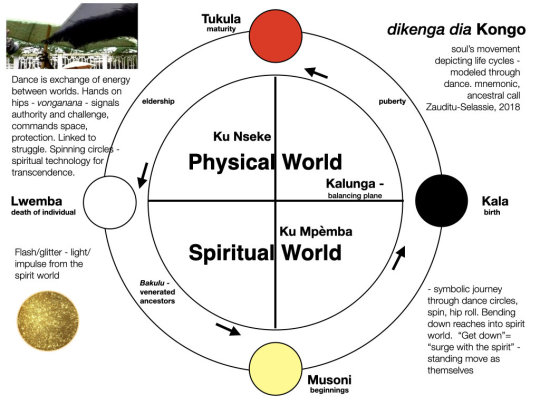
Archeologists also found the Kongo cosmogram on several plantations in the American South; they were Richmond Hill Plantation in Georgia, Frogmore Plantation in South Carolina, a plantation in Texas, and Magnolia Plantation in Louisiana. Historians call the locations where crossroad symbols were possibly found inside slave cabins and African-American living quarters as 'Crossroads Deposits.' Crossroads deposits were found underneath floor boards and in the northeast sections of cabins to conjure ancestral spirits for protection. Sacrificed animals and other charms were found where the crossroads symbols were drawn by enslaved African-Americans and four holes drilled into charms to symbolize the Bakongo cosmogram. Other West-Central African traditions found on plantations by historians is the use of six pointed stars as spiritual symbols. A six pointed star is a symbol in West Africa and in African-American spirituality.

On another plantation in Maryland archeologists unearthed artifacts that showed a blend of Central African and Christian spiritual practices among slaves. This was Ezekiel's Wheel in the bible that blended with the Central African Kongo cosmogram. This may explain the connection enslaved African Americans had with the Christian cross as it resembled their African symbol. The cosmogram represents the universe and how human souls travel in the spiritual realm after death entering into the ancestral realm and reincarnating back into the family. The artifacts uncovered at the James Brice House were Kongo cosmogram engravings drawn as crossroads (an X) inside the house. This was done to ward a place from a harsh slaveholder. Also, the Kongo cosmogram is evident in Hoodoo practice among African Americans. Archeologists unearthed on a former slave plantation in South Carolina clay bowls made by enslaved Africans that had the Kongo cosmogram engraved onto the clay bowls. These clay bowls were used by African Americans for ritual purposes.

The Ring shout in Hoodoo has its origins from the Kongo region from the Kongo cosmogram (Yowa Cross) and ring shouters dance in a counterclockwise direction that follows the pattern of the rising of the sun in the east and the setting of the sun in the west. The ring shout follows the cyclical nature of life represented in the Kongo cosmogram of birth, life, death, and rebirth. Through counterclockwise circle dancing, ring shouters built up spiritual energy that resulted in the communication with ancestral spirits, and led to spirit possession by the Holy Spirit or ancestral spirits.
Enslaved African Americans performed the counterclockwise circle dance until someone was pulled into the center of the ring by the spiritual vortex at the center. The spiritual vortex at the center of the ring shout was a sacred spiritual realm. The center of the ring shout is where the ancestors and the Holy Spirit reside at the center. The ring shout tradition continues in Georgia with the McIntosh County Shouters. At Cathead Creek in Georgia, archeologists found artifacts made by enslaved African Americans that linked to spiritual practices in West-Central Africa. Enslaved African Americans and their descendants after emancipation house spirits inside reflective materials and used reflective materials to transport the recently deceased to the spiritual realm. Broken glass on tombs reflects the other world. It is believed reflective materials are portals to the spirit world.
#bakongo#kongo#congo#cathead creek#mcintosh county#african american#west central africa#spiritual vortex#cross#cosomogram#yowa cross#cosmogram#african#afrakan#kemetic dreams#brownskin#africans#afrakans#african culture#afrakan spirituality#Ezekiel's Wheel#Magnolia Plantation
79 notes
·
View notes
Text


From a Free and Wild Life to Civilized Society
We are taught to believe that our modern lifestyle, characterized by competition, inequality, and oppression, is an improvement over the past. But when one considers the facts of human history, this misconception could not be more false. On the contrary, we have things to learn from our egalitarian past which reveal how we can revive the anarchy in our world.
An old African fable teaches us the following:
A group of nomads come upon a tree full of ripe fruit and hold a feast. In the morning, as they want to depart, a young man fills a pack with fruit to take with them on the journey so that they will will have more to eat. An older person in the group stops him: “We don’t have many rules, but the most important is: We thank, we enjoy, but we don’t take with.” The young man asked: “But why not?” The elder answered: “Because the world is rich and will take care of us. But when we take more than what we need, it is the beginning of the end of our carefree lives and brings the entire world to catastrophe.”
Pre-civilized lifeways in Africa had such a precise and deep understanding of the exact nature of their relationships and their impacts on individual quality of life as well as our collective fate, as did similar nomadic lifeways throughout the whole world. These groups managed to lead a peaceful, egalitarian life free from all authority and oppression, before pastoralism and settlement and finally civilization was established. For at least 500,000 years – it was probably more like two million years – our ancestors found a way to live in lasting harmony with nature. This changed with the arrival of agriculture and civilization around 10,000 years ago.
In nomadic lifeways there is no place for the accumulation of property and therefore there is also no great difference in material possessions. As a rule nomads only own what they can carry. The anthropologist Marshall Sahlins coined the term “Original Affluence” to describe the lifestyle of hunter gatherers. This concept of affluence means: “having enough of everything necessary to satisfy ones needs and a lot of free time to enjoy life.” Hunter-gatherers reach affluence in the sense that they want little and don’t produce much, that is they are free of greed. Nomads live in groups in which there is as good as no material wealth, but in exchange true wealth: lots of free time to truly enjoy life. The generally high level of satisfaction, happiness, and love of art, music, dance, and social games is well documented among many original peoples like the forest peoples in Central Africa, Aboriginal Australians, and the various Indigenous Peoples of the Americas.
This original way of life, enjoyed by our ancestors throughout the great majority of humanity’s time on this earth, has survived even to this day, though it has retreated sharply and almost died out. In Indonesia and other parts of Southeast Asia, in the Amazon regions of South America, and scattered over all of Africa there remain fully functioning nomadic micro-cultures, which are similar or completely identical to the life of “Original Affluence.” Although there are differences between these surviving groups, they have many commonalities. The best documented present hunter-gatherers are the Hadza in Tanzania, East Africa, and the Dobe Ju/'hoansi of Southern Africa who live in and around the Kalahari desert.
A short summary of the most important characteristics of hunter-gatherers:
-Work (mostly the procurement of food) requires less than half the time that civilized people spend in factories, offices, and other workplaces. The absolute majority of food is gathered, while the hunt composes only a small portion. Work and play are identical.
-Everyone has enough to eat and there is no hunger – by comparison, over 30% of the population in industrial societies go hungry.
-There is no concept of private property.
-Children are raised “permissively.” They educate themselves through their own self-determined play and exploration. Corporal punishment is non-existent.
-Outstanding health. Sickness is very rare. When one person is sick or disabled, they are lovingly cared for by the rest of the group.
-There is no hierarchy, no authority
-Everyone has the same access to resources.
-If one person shows shitty behavior, this person will be shunned until they cease their bad behavior. Otherwise this person decides for themselves to join another group, because no one lives (or survives) long on their own.
The few still-living nomadic groups were crowded out towards the least productive regions, the edge of their earlier living spaces, over the last 10,000 years in countless waves of marginalization by civilized peoples.
There is a multitude of studies on the original transition from nomadic to settled tribes. For instance, the San People in southern Africa (to which the Dobe Ju/'hoansi belong) lived peacefully and sustainably for hundreds of thousands of years before the Bantu peoples came from the north. The Bantus brought along agricultural methods and technologies, creating food surpluses and a rapid rise in population, following which massive and bloody wars between the tribes began.
There are many examples showing that inequality and the proportion of violence continued to rise after the arrival of agriculture. The isolated Enga tribe in Papua New Guinea traditionally lived on taro, yams, half-domesticated pigs, and a little wild game. But the introduction of the sweet potato, a quick and easy growing plant from South America, led to a significant rise in the food surplus. This surplus was fed to the pigs, whose population multiplied. Pigs became the means of exchange in trade. There thus arose a new political class which did no real work, instead controlling and manipulating the trade to their own advantage. In comparison to the poor farmers they became very rich. Every trace of equality disappeared from there and wars became ever bigger and more frequent.
Thus humanity traded quality for quantity and gave up freedom and autonomy for hard work and security. Life has deteriorated from many different perspectives, for instance through the reduction of our nourishment from thousands of different plants to just a few cultivated varieties, leading to the emergence of many new, modern diseases. With continuous growth and consumption have finally arisen the “Diseases of Civilization” familiar to us today: cancer, diabetes, heart attacks, broken digestive health, and much more.
Agriculture brought so many downsides to human life that the scientist Jared Diamond described it as the worst mistake in the history of humanity when he wrote: “Besides malnutrition, starvation, and epidemic diseases, farming helped bring another curse upon humanity: deep class divisions… Thus with the advent of agriculture and elite became better off, but most people became worse off. Farming could support many more people than hunting, albeit with a poorer quality of life… Some bands chose [agriculture]… outbred and then drove off or killed the bands that chose to remain hunter-gatherers, because a hundred malnourished farmers can still outfight one healthy hunter…. It's not that hunter-gatherers abandoned their life style, but that those sensible enough not to abandon it were forced out of all areas except the ones farmers didn't want.”
With the new lifestyle there also came a new division of labor. Farmers worked much more than before to feed everyone, while others concentrated on such things as the production of weapons and technologies. The accumulation of more property brought the rich more negotiating power and led to an exponential rise in wealth, meaning that the higher class increasingly exploited the work of the lower class for their own profit. The transition also brought with it the arrival of centralized power. Social inequality rose ever higher while societies became ever larger and more complex. Technological progress enabled an even more dramatically unequal distribution of wealth.
If the history of humanity started at midnight, then we would almost be at the end of our first day. We have lived almost the entire day as hunter-gatherers, from midnight through dawn, midday, and dusk. Finally, at 11:54 PM, we started raising crops. Hunter-gatherers practiced the most successful and long-lasting lifestyle in human history. By contrast, we have been fighting for some 10,000 years against the chaos that agriculture and civilization has landed us in. It is unclear if we can find a solution.
It’s high-time we protect the ancient history of anarchism from systematic extinction. It could be the key to our common future.
#affinity groups#anti-civ#anti-colonialism#anti-technology#Black#Black Anarchism and Black Anarchic Radicals#decivilizing#decolonization#disability#egoism#german#indigenous#interpersonal relationships#post-civ#post-colonialism#switzerland#translation#anarchism#anarchy#anarchist society#practical anarchy#practical anarchism#resistance#autonomy#revolution#communism#anti capitalist#anti capitalism#late stage capitalism#daily posts
7 notes
·
View notes
Text
Some animal species discovered/rediscovered recently because the news always sucks
(Discovered in the past two-ish years)
Giant new snake species identified in the Amazon (Northern green anaconda)
This Bird Was Declared Extinct In 1898 And Rediscovered 50 Years Later (takahē)
Meet the 'vampire' hedgehog (Hylomys makarong)
Lost tap-dancing spider rediscovered barricaded in a burrow in a small Portuguese town after 92 years (Fagilde’s trapdoor spider)
4-foot reptilian predator spotted 'enveloping' hawk turns out to be new snake species (coal black tree snake)
Chel snakehead, fish species believed to be extinct, spotted in India after 85 years (Chel Snakehead fish)
New species of horseshoe bat identified in East Africa (Webala’s horseshoe bat)
Galapagos rail rediscovered on Floreana after 190 years (Galapagos rail)
New Antarctic Dragonfish Species Discovered (Banded dragonfish)
Rediscovery of the Victorian grassland earless dragon after 50 years (Victorian grassland earless dragon)
New gecko species discovered in the Northern Cape (Gravel Pygmy Gecko)
Golden Mole That Swims through Sand Rediscovered after 86 Years (De Winton's Golden Mole)
New damselfly species discovered in Wayanad (Wayanad Torrent Dart)
New fish species discovered in the Gulf of Mexico (Campeche Bank hamlet)
New skink a second unique species for Scawfell Island (Scawfell Island sunskink)
ZSI scientists discover new species of Indo-Burmese pangolin (Indo-Burmese pangolin)
Newly Discovered Gecko Species Named After Vincent van Gogh (Starry night gecko)
New species of tropical moth from Guyana discovered in Port Talbot living room (Cadet's clearwing moth)
New Species of Glass Frog Discovered in the Andes (New Andean glass frog)
Meet the new chief of the South African reefs: The Sodwana Pygmy Pipehorse (Sodwana Pygmy Pipehorse)
#mental health#positivity#self care#mental illness#self help#recovery#news#current events#cute#animals#cute animals#dogs#cats
5 notes
·
View notes
Text

Unlocking Ghana's Cultural Tapestry: A Journey Beyond Accra.
When travelers think of Ghana, the bustling capital city of Accra often takes center stage. While Accra offers a glimpse into the nation's vibrant energy and diversity, the true essence of Ghanaian culture lies in the distinct regional identities that exist beyond the city limits. To unlock a deeper understanding of this West African gem, it's essential to venture out and immerse yourself in the captivating cultural landscapes that make Ghana so remarkable.
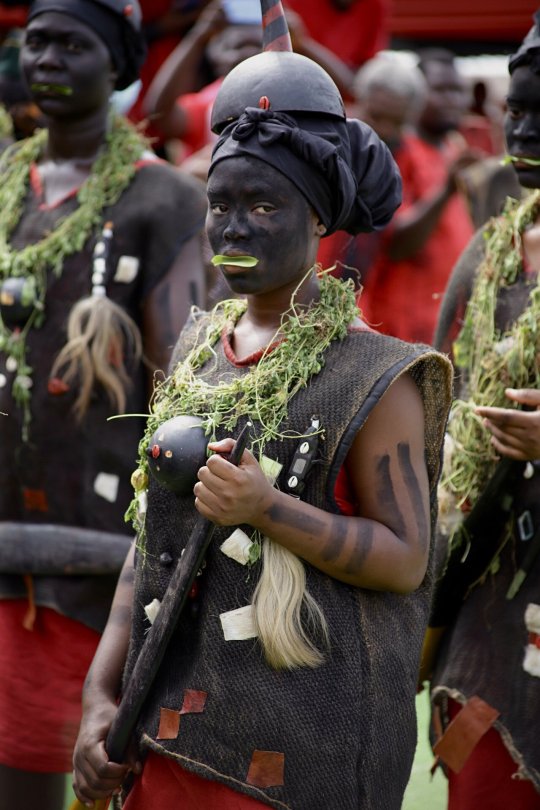
Start your cultural odyssey in the Ashanti Region, the heartland of the prestigious Ashanti Kingdom. At the center of this cultural epicenter lies Kumasi, a city that pulses with history and tradition. Wander the halls of the magnificent Manhyia Palace, the seat of the Asantehene, the revered Ashanti monarch, and witness the grandeur of the Akwasidae Festival. This spectacular celebration honors the Ashanti's royal ancestors through mesmerizing dances, rhythmic drumming, and the intricate display of ornate kente cloth. Dive into the region's rich artisanal legacy by exploring the workshops of skilled kente weavers and gold jewelry makers, whose craftsmanship has been honed over generations.

Venture north to the captivating Northern Region, where the Dagomba, Gonja and other tribes have preserved their distinct cultural identity. In the bustling city of Tamale, marvel at the Sahelian-style architecture, with its mud-brick structures and striking silhouettes. Attend a traditional funeral ceremony or the vibrant Damba Festival, which commemorates the birth of the Prophet Muhammad through a dazzling display of music, dance, and religious rituals. Seek out the ancient mud-brick mosques, such as the Larabanga Mosque, one of the oldest in West Africa, and immerse yourself in the region's deep Islamic heritage.

Shifting your focus eastward, the Volta Region offers a glimpse into the unique Ewe culture. In towns like Ho and Keta, witness the mesmerizing traditional dances and learn about the Ewe's captivating language and culinary traditions. Explore the picturesque landscapes of the region, from the cascading Wli Waterfalls to the serene Kalakpa Resource Reserve, where you can connect with the rhythms of nature and the local communities.

Staying within the Greater Accra Region, venture to the fishing villages of Jamestown and Chorkor to experience the vibrant Ga culture. Observe the daily lives of the Ga people, their colorful architectural style, and their rich cultural celebrations, such as the Homowo Festival, which commemorates the victory over famine. Engage with the local artisans and learn about their time-honored crafts, from pottery to basket weaving.

Finally, make your way to the Central Region to immerse yourself in the Fante culture. Explore the historic towns of Cape Coast and Elmina, where the remnants of colonial-era forts and castles stand as silent witnesses to the region's complex past. Observe the traditional fishing practices and vibrant local markets, and attend the Oguaa Fetu Afahye, a captivating Fante cultural festival featuring music, dance, and mouthwatering cuisine.

By venturing beyond the confines of Accra, you'll unlock a deeper understanding of Ghana's diversity and the unique regional identities that make this country so captivating. Each region offers a distinct cultural experience, from the regal Ashanti heritage to the centuries-old Islamic influence in the north, the mesmerizing Ewe traditions in the east, the vibrant Ga community in the capital, and the maritime Fante culture in the center. Embrace the opportunity to connect with the local people, learn about their customs and beliefs, and leave with a newfound appreciation for the richness and complexity of Ghanaian culture.
So pack your bags, open your heart, and embark on a cultural odyssey that will leave you forever transformed by the diversity and beauty of Ghana, beyond the boundaries of its capital city. Unlock the true essence of this remarkable nation by venturing out and immersing yourself in the captivating regional identities that make Ghana a cultural tapestry worth exploring.
#bestghanatours#tourism#travel#ghana#tour package#accra ghana#tourist#travelwithus#worldwide privacy tour#summer#private#private tour#city tour#accra#voltaregion#northern lights#safari#nature#wildlife#adventure#marketing#sale#black tumblr#blacktravel#travelgram
6 notes
·
View notes
Text
Leg rattles in southern African music
Question (@culmaer): I've been slowly making my way through Percival Kirby's book on South African instruments (published in 1934), and I assume the spellings he uses for words from the various 'Khoisan' languages are ad hoc, phonetic transcriptions and not the standardised spellings in use today. part of me was hoping there was maybe a contemporary survey of instruments, or perhaps just easily accessible dictionaries/word-lists I could go through to check the spellings he uses
Kirby mentions ankle rattles made of springbok ears of the "Qung Bushmen" and cites the name from Bleek and Lloyd's Bushman Folk-lore as |keriten. I assume by Qung he means !Kung, but I'm not sure how similar !Kung and |Xam are, or if Kirby is making an attribution error ? nevertheless, are you able to verify that name and spelling ?
then, I'm particularly curious about a springbok horn flute, per Kirby, "used by the Kalahari Bushmen near Haruchas, SWA, [which] they call |garras or |garris" as well as a similar instrument used by the "Berg-Dama" called ǂnunib, although their version apparently stopped the horn with wood to create a more specialised embouchure, which I would love more details on. are these instruments still played ?
!Xun (<!Kung>) and |Xam belong to different language families: !Xun is a Kx’a language spoken along the northwestern Kalahari Basin fringe (northern Namibia, southern Angola, northwestern Botswana). |Xam was Tuu language of the !Ui subbranch which was spoken in the west of South Africa, all the way down to the Cape. |Xam went extinct during the first half of the 20th century, while !Xun is still a vibrant language with multiple dialects. !Xun and |Xam speakers were probably not in contact with each other in historical times, but received both influence from Khoekhoe herders (who speak an unrelated language of the Khoe-Kwadi family).
Kx’a and Tuu are resident language families exclusively spoken by foragers, while Khoe-Kwadi languages were introduced from the east around 2,000 years ago; at present, they are spoken by foragers (“Kalahari Khoe”) and herders (“Khoekhoe” and the extinct Angolan language “Kwadi”).
The ‘leg rattle’ word you cite here seems pretty widespread:
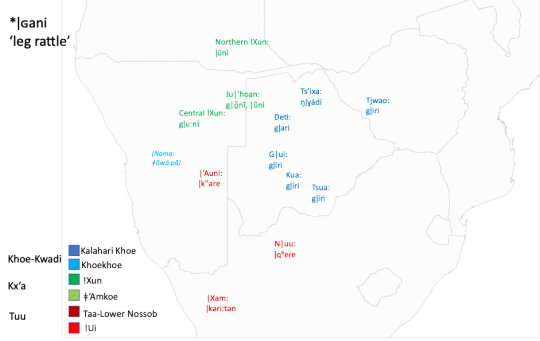
Interestingly, the root *ǀɢani (my reconstruction) is indeed distributed across all three families. The underlying uvular onset (uvularity is still visible in N|uu) is responsible for the sound changes /a/ > /u/ and /n/ > /r/. It is impossible to say which of the three families is the source and I am inclined to believe that this root may be very old and refer to a very widespread cultural practice (i.e., dancing with leg rattles) (this is not to say it is evidence for a “Khoisan” family; just for a very old contact area).
I wonder whether Kirby’s “|garras or |garris” ‘springbok horn flute’ is actually the same root. The word is certainly from Khoekhoe because it has the feminine singular suffix -s. The location where it was recorded, Haruchas, also seems Nama-territory to me, so I strongly doubt this was recorded among “Kalahari Bushmen”. Haacke & Eiseb (2002) have an entry <ǀgȁríb> ‘quick grass, esp. Cynodon dactylon’, but that does not seem to make a lot of sense here - unless, of course, Kirby got confused and the word he lists actually denotes a grass flute. Damara ǂnunib appears to be the standard Khoekhoe word for ‘flute, play flute’ (Haacke & Eiseb 2002: 415).
Leg rattles are still very common in many San and San-descendant groups from southern Africa. They are also used by some Bantu groups like the Tswana, probably due to influence from neighboring hunter-gatherers.
In the Botswanan San group I worked with for many years, leg rattles are especially used in ritual performances which are not meant for strangers to witness. However, I have videos from a cultural workshop in which a San group from Zimbabwe performs with leg rattles. I'll share the videos as soon as I am back in office next week.
The Khoekhoe flutes are, to the best of my knowledge, no longer used. I will make a post on that (and the terms associated with the flute ensembles) tomorrow.
8 notes
·
View notes
Text
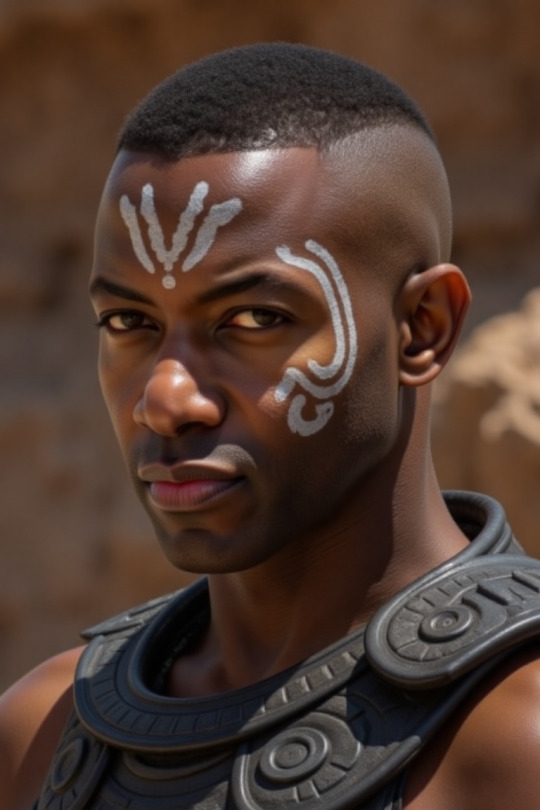
Iz'Angel – The Rave Legend Behind Africa's New Electronic Music Revolution
When you think of the UK rave scene in the '90s and early 2000s, one name that echoes through the underground halls and bass-heavy dance floors is Iz’Angel. Known for his bold, boundary-breaking events and a near-mythical presence in London and Ibiza's nightlife, Iz’Angel is no stranger to changing the game. And now, he's doing it again—but this time, the revolution is African.
youtube
Welcome to African Jahva, the futuristic fusion genre redefining the global sound of electronic dance music.
From London Basements to Global Stages
Iz’Angel was born into the fire of the UK’s underground rave explosion. He was more than a DJ or promoter; he was a visionary architect of spaces where music, people, and culture collided. From Electrybe to Lazerdrome, Raw Club to the iconic London Astoria, Iz'Angel was behind some of the most unforgettable nights in rave history. His reputation earned him a passport to the global scene, especially the hedonistic heart of dance music—Ibiza.
In Ibiza, he curated wild nights at clubs like Es Paradis, Pacha, Space, and Privilege, pulling in thousands of partygoers. He even ran epic events at Kaos, now known as Eden, before founding one of the most legendary venues in East London: LOVE, a 24-hour rave club in Shoreditch.
LOVE was notorious for its gritty glamour and iconic after-parties like Trailer Trash and
Babushka by Pushca. Even after an infamous police raid shut it down, Iz'Angel relocated the movement to Hamburg's Reeperbahn, then eventually back to Ibiza and onward to Miami, keeping the rave fire alive across continents.
His revolutionary journey through the electronic music world was immortalized in the cult book "Rave Story", a must-read for anyone serious about the history of dance culture.
A New Chapter: African Jahva is the African RAVE SCENE!
Now, Iz’Angel has turned his energy and genius to the continent where rhythm was born.
African Jahva is his brainchild—a genre that fuses Afro House, techno, electronica, and
traditional African languages into one hypnotic, high-energy experience.
This isn’t just a sound. It’s a cultural awakening. African Jahva blends ancient African voices with futuristic beats, creating a genre that pays homage to the past while launching into the future. It embodies Afrofuturism, Pan-African pride, and a universal message of peacehttps://youtu.be/JIkasjddNaQ?si=ZzTv4Z-mhObvBEDC
youtube
Iz'Angel the Cultural Curator
Iz'Angel isn’t just remixing African music. He’s curating an entirely new global identity for it.
Songs in Akan, Amharic, Fula, Hausa, Igbo, Luganda, Mandinka, Swahili, Yoruba, and Zulu can be heard pulsing through his tracks. Each beat tells a story. Each language reclaims its power.
The genre has already taken off on platforms like TikTok and YouTube, with viral dance challenges and an ever-growing community of DJs and fans. Through African Jahva Radio, Iz'Angel is connecting 50 African DJs across 12 countries, each producing half-hour mixes featuring five African Jahva tracks. It's a sonic revolution sweeping the continent—and now the world.
Perfect Timing!
In a time when global music often overlooks Africa’s deeper cultural reservoirs, Iz’Angel is spotlighting them with flair, respect, and innovation. He’s not appropriating; he’s amplifying. And he’s doing it with the passion of someone who’s been part of music history from the start.
For anyone who lived through the golden age of UK raves, Iz’Angel is already a legend. For today’s generation discovering him through African Jahva, he's a revolutionary force blending two worlds into one unforgettable sound.
youtube
Join the Movement
Whether you’re a fan of electronic music, a lover of African culture, or someone looking to be part of the next big thing in global sound, Iz’Angel and African Jahva invite you to dance, connect, and transform.
Follow the movement. Subscribe to the YouTube channel. Feel the vibe.
Because the future of global dance music? It’s African. And it sounds like Jahva.
Subscribe now: https://www.youtube.com/channel/UCoy9Gf98KkVEKBjRVpOSgYw
#AfricanJahva #IzAngel #UKRaveScene #IbizaNightlife #Afrofuturism
2 notes
·
View notes
Text
More on Hoodoo (spirituality)
In my previous post I talked about traditional hoodoo where it started I want to talk a little more on it.
Let's start with this 'The origins of the word Hoodoo which actually comes from the real term "Hudu", meaning "spirit work," coming from the Ewe language spoken in the West African countries. No. It does not come from Africa but African Americans in the American south.
As I mentioned in a past post the term Hoodoo mean that you are sending someone up the river, the upper room. aka death. This is what it means. But in this time it's use to represent all forms of root work in this practice or others. This was started by marketeers.
SWEETENING JARS:
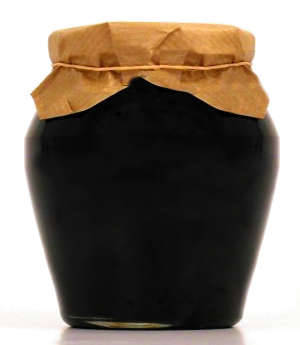
Traditional Sweeting Jar
Sweetening jars is traditional in Hoodoo to sweeten a person or a situation in a person's favor. The practice is appropriated and its meaning is misunderstood outside the African-American community. Traditionally sugar is added to water and used.. Not Honey.
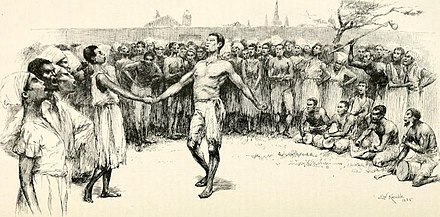
During the slave trade, the majority of Central Africans imported to New Orleans, Louisiana were Bakongo (Bantu people). This image I like and wanted to show it if anyone hasn't seen it. It was painted in 1886 and shows African Americans in New Orleans performing dances from Africa in Congo Square. Congo Square was where African Americans practiced Voodoo and Hoodoo. ("So again when any non traditional Root Worker says there isn't a little voodoo with hoodoo there wrong")
Next we have this diagram the Kongo Cosmogram Cross.
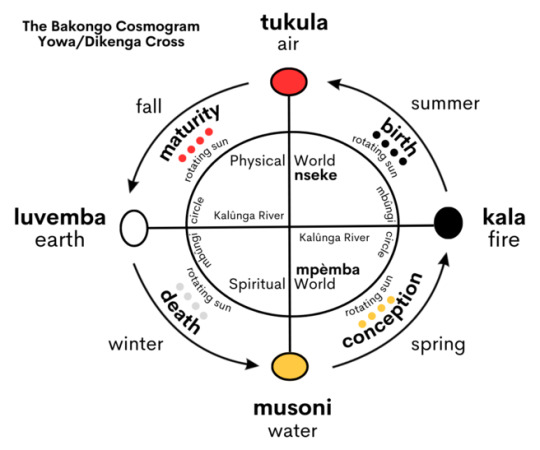
Kongo Cosmogram aka Crossroads.
The Kongo cosmogram aka The Crossroads is from Bakongo origins. This shows how different African religions teach simulator things.
Why is it important? The basic form of this symbol is a simple cross (+) which (symbolizes the rising of the sun in the east, the setting of the sun in the west, and represents cosmic energies.)
This shows that we do use the sun but not the moon like books may teach.
However, the cross is not the same as your typical Christian cross.
The vertical line of the cosmogram is the path of spiritual power from God at the top traveling to the realm of the dead below where the ancestors reside.
The horizontal line in the cross represents the boundary between the physical world which is the (realm of the living) and the spiritual world (realm of the ancestors).
The horizonal line is a watery divide that separates the two worlds from the physical and spiritual, and thus the "element" of water plays a role in African American spirituality just like Voodoo.
The Kongo cosmogram cross symbol has a physical form in Hoodoo called the crossroads where Hoodoo rituals are performed to communicate with spirits.
Dancing: Counterclockwise sacred circle, dances in Hoodoo are performed to communicate with ancestral spirits using the sign of the Yowa cross.
The Ring shout Is Not Part of traditional Hoodoo as far as the actual rituals are concerned, but it is part of church that has its own origins. The ring shout follows the cyclical nature of life that we see in the diagram. It represents Kongo cosmogram of birth, life, death, and rebirth.
Through counterclockwise circle dancing, ring shouters built up spiritual energy that resulted in the communication with ancestral spirits, and led to spirit possession by the Holy Spirit or ancestral spirits. The spiritual vortex in the center of the ring shout is a sacred spiritual realm. The center of the ring shout is where the ancestors and the Holy Spirit reside at. The ring shout tradition continues in Georgia. Inside reflective materials and the used of reflective materials to transport the recently deceased to the spiritual realm. Broken glass on tombs reflects the other world. It is believed reflective materials are portals to the spirit world.
#Hoodoo Lesson#spiritual#like and/or reblog!#traditional hoodoo#rootwork#google search#southern hoodoo#Hoodoo history#Real hoodoo#ask me anything#Hoodoo initiation#Ring shot#follow my blog#ask me questions#message me
77 notes
·
View notes
Text
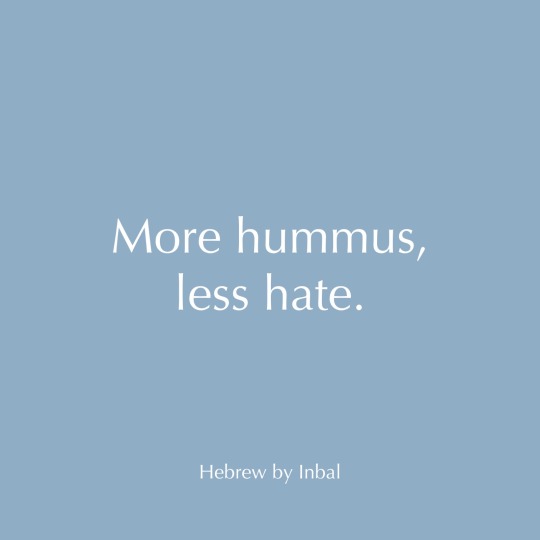
Cultures are the tapestries of human existence—vivid, dynamic, and profoundly interconnected.
From the aromatic allure of cuisines to the rhythmic complexities of languages and the rich traditions of customs, every culture offers a window into the souls of its people.
Throughout history, humans have migrated, crossed seas and mountains, shifted borders, and mingled narratives, creating a beautiful mosaic of shared histories and divergent paths.
Take Israeli cuisine, for example.
It’s a vibrant fusion that mirrors the diverse heritage of the Jewish people. From the aromatic spices of the Middle East to the hearty stews of Eastern Europe, each dish tells a story of migration and settlement.
Jews returning from diasporas across Europe, North Africa, and the Middle East brought with them culinary traditions as varied as the lands from which they came.
These traditions have mingled on the Israeli table, creating a cuisine characterized by its diversity and the capacity to unite flavors in astonishing ways.
This blend of tastes and traditions serves as a reminder: the land we live on is not really ours; it belongs to the planet. We are merely tenants here, not owners.
In this light, embracing and celebrating different cultures becomes a path to greater happiness and understanding.
Whether it's through enjoying a plate of hummus, dancing to a klezmer melody, or learning a few phrases in another tongue, every small act of cultural appreciation enriches our lives, making the global village a more connected and joyful place.
So, let's celebrate the diversity around us.
Dive into the myriad of cultures, foods, music, and languages.
You'll find that in celebration, there is a profound joy and a deeper connection to the world and its people.
You will be so much happier.
#jewish culture#jewish#israeli#israeli cuisine#travel#hebrew langblr#language#langblr#jumblr#hummus#hate
14 notes
·
View notes
Text

Masalit dance available at my INPRNT with proceeds to @sudansolidaritycollective & @kudusi2020 , which works to support Masalit culture in the US.
The Masalit are an indigenous African tribe in Darfur area of Sudan, who speak Masarak. They, along with other non Arab tribes, have been historically targeted in repeated genocides including by the RSF today. The dance is vigorous and happy, where groups (of any genders) take turns jumping up and down in duos or trios in unison.
#sudan#sudan genocide#dancing through sudan#dancing through east africa#funds for sudan#masalit#masalit culture#masalit dance#illustration#my art#my doodles#art
40 notes
·
View notes
Note
Don’t worry little retard, the Israelis will keep living and dancing while Hamas keeps being the real reason why gazans suffer. Talk to Israelis and not your polsci classmates in the US about what’s going on in the Middle East and maybe you’ll learn something
the state of israel is and allways has been an imperialist project meant to establish an ethnostate visa-vi ethnically cleansing the Palestinian people. Hamas, the rightwing-religious political/military group, was funded by israel to oppose the leftwing/socialist parties in palestine and destabilize the area. And it bit them in the ass, much in the same way as with the united states and al-quaeda. Polysci-classes most often simply mention israel as "the only democracy in the middle east" and move on. I, largely through talking with israelis and what a lot of them have been propagandized to think about palestinians, and with a few socialists from there who are likewise horrified at the nationalist program. Lord willing it goes the same way as its kin of aparthied south africa, its economy isolated and collapsing due to its insistence that it stay in the spirit of a previous era.
Death to the genocidal nation-state of israel, life to all those who struggle under the god of abraham.
4 notes
·
View notes
Text
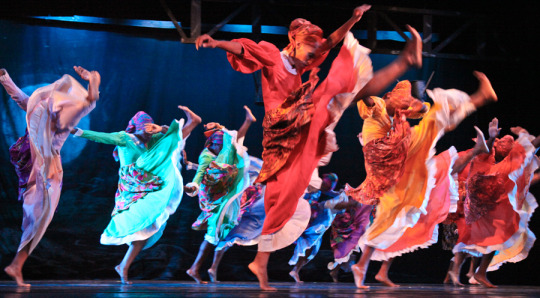
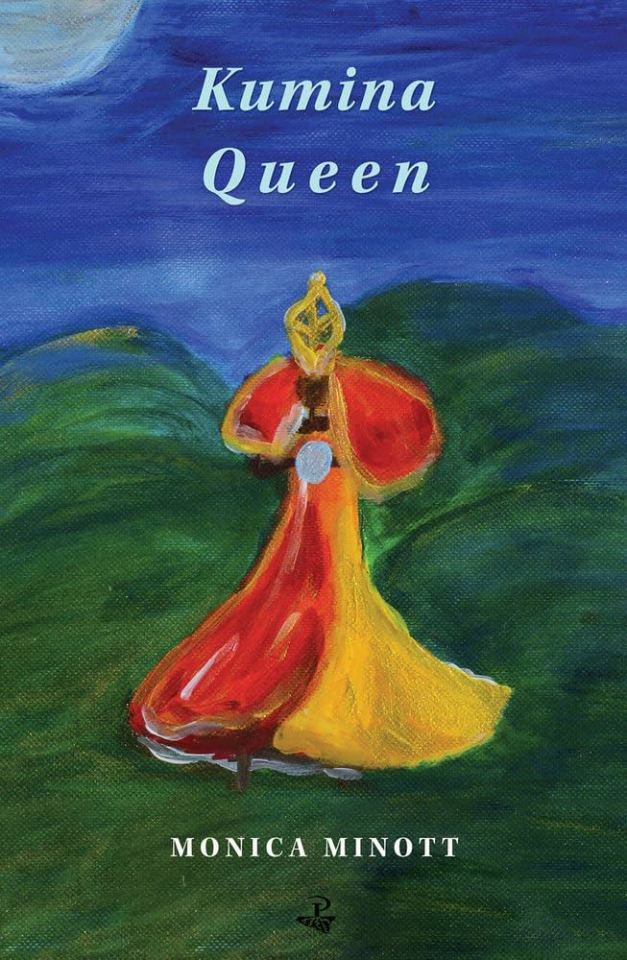
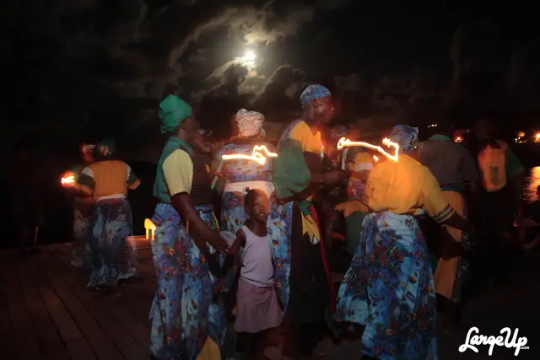
Kumina is an Afro-Jamaican religion. Kumina has practices that include secular ceremonies, dance and music that developed from the beliefs and traditions brought to the island by Kongo enslaved people and indentured labourers, from the Congo region of West Central Africa, during the post-emancipation era. It is mostly associated with the parish of St. Thomas in the east of the island. However, the practice spread to the parishes of Portland, St. Mary and St. Catherine, and the city of Kingston.

Kumina also gives it name to a drumming style, developed from the music that accompanied the spiritual ceremonies, that evolved in urban Kingston. The Kumina drumming style has a great influence on Rastafari music, especially the Nyabinghi drumming, and Jamaican popular music. Count Ossie was a notable pioneer of the drumming style in popular music and it continues to have a significant influence on contemporary genres such as reggae and dancehall.
The Kumina riddim is a dancehall riddim produced by Sly & Robbie in 2002. It has featured in recordings of over 20 artists including Chaka Demus & Pliers and Tanya Stephens.
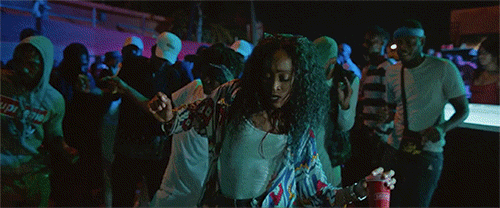
Kumina is an Afro-Jamaican Religion and is not the same as Pukkumina or Pocomania.
Kumina emerged through the practices of indentured labourers who were brought to Jamaica from the Kongo region of central Africa after the abolition of slavery. In the second half of the 19th century it syncretised with Myalism. Kumina differed from Zion Revivalism in rejecting the belief that the Bible should be the central authority behind worship.
The practices of Kumina are primarily linked to healing.[4] Healing ceremonies utilise singing, dancing, drumming, animal sacrifice, and spirit possession, with the intent of summoning spirits to heal the sick individual. These elements are also found in Myalism and Zion Revivalism.
Organization of Kumina communities follows the general local character of African religions in Jamaica. Kumina communities are small family based communities or nations. Some nations include Mondongo, Moyenge, Machunde, Kongo, Igbo, and Yoruba. People from Kumina families are given the title Bongo. Marrying into a Bongo family is one avenue to become a part of a Kumina nation; special initiation is the other avenue. Kumina nations are led by a "King" and "Queen". Imogene "Queenie" Kennedy AKA Queenie III (c1920-1998) was a well-known Kumina Queen in the 20th century, born in St Thomas in the late 1920s she later moved to Kingston and then Waterloo, St Catherine.


The use of cannabis or ganja in Kumina may have been an influence on the adoption of this plant as a sacrament in Rastafari, a religion that developed in Jamaica during the 1930s.
#kumina#afro jamacian#jamaican#rastafari#african#afrakan#kemetic dreams#africans#brown skin#afrakans#african culture#afrakan spirituality#brownskin#rasta#rasta love#dancing rasta#rastaman#kisumi amau#impulsesv#tegan and sara#sexy nerd
17 notes
·
View notes
Text
From Qaraami to Dance-Pop - Women of East Africa

Starting our journey off in... Eastern Africa! Yeah, alright, maybe spoiled slightly in the title of the post.
I've had so much fun with this over the last few weeks, and the result of that is brought to you here through some of my top picks. A moment of silence for the albums I wanted to include but didn't due to not being easily accessible </3
The list is not ordered or ranked in any way, though I will admit I've a certain fondness for Saba and Khadja Nin in particular <3.
For ease of access, here's a playlist of some top tracks from each album (ca. and hour and a half), here's an extended version with additional tracks from some artists not featured on this list (ca. two and a half hours), and here's a playlist of the full albums (ca. seven hours), for all your shuffling needs.
Saba - Jidka (2007) Spotify Youtube - A fun and playful somali italian-influenced pop record with some elements R&B, uplifting and a joy to listen to. As a side node, Saba's life story is definitely a google worth, imo.
Mim Suleiman - Umbeya (2012) Bandcamp Spotify Youtube - An obvious inclusion in my book, just a great beat / electro album with some elements of soul. You really fall into the world of this album.
Aster Aweke - Aster (1989) Spotify Youtube A lovely Tizita album, a gem of ms. Aweke's sizeable discography (which you are definitely encouraged to dig into <3). I am so in love with the horns and little flourishes, and the rhythm is just... mwah. Aweke ties it all together really well.
Khadja Nin - Ya Pili (1994) Spotify Youtube - A already mentioned my fondness for Ms. Nin, but damn if it doesn't bear repeating... By all accounts an incredible record that really should be on your list.
Faytinga - Numey (2006) Spotify Youtube - The steady rhythms and Faytinga's distinctive vocals makes for a great experience certain to draw you in. Impresseive record from an equally impressive person.
Muthoni Drummer Queen - She (2018) Bandcamp Spotify Youtube - A bubbling hip hop album with some flavors of R&B and dancehall. The production on this is great and Muthoni is an incredibly engaged performer. It's just overflowing with life and so, so definitely worth a listen.
Sophie Nzayisenga - Queen of Inanga (2021) Bandcamp Spotify Youtube - The album title says it all, really. Even as someone who's not traditionally drawn to the acoustic for the most part, I really enjoyed this album.
Maryam Mursal - The Journey (1998) Bandcamp Spotify Youtube - An unavoidable inclusion on a list like this, and for good reason. A poppy qaraami record with some jazzy notes that deserves all of the acclaim it's gathered over the years - Mursal clearly knows what she's doing and she does it well.
MC Yallah - Yallah Beibe (2023) Bandcamp Spotify Youtube - Ending here with a very recent release, MC Yallah's latest is just such a solid hip hop record. It flows really well, and the industrial undertones really worked for me, which is rare. Definitely someone to keep a look on, imo.
... and that's the list!
Do you have any favorites not on here? Please (please <3) feel more than free to share! Have fun!
#women in music#music#discover music#women in pop#women in hip hop#playlist#women in art#feminism#somalia#tanzania#ethiopia#burundi#eritrea#kenya#rwanda#uganda#wmc#theme: around the world
8 notes
·
View notes
Text
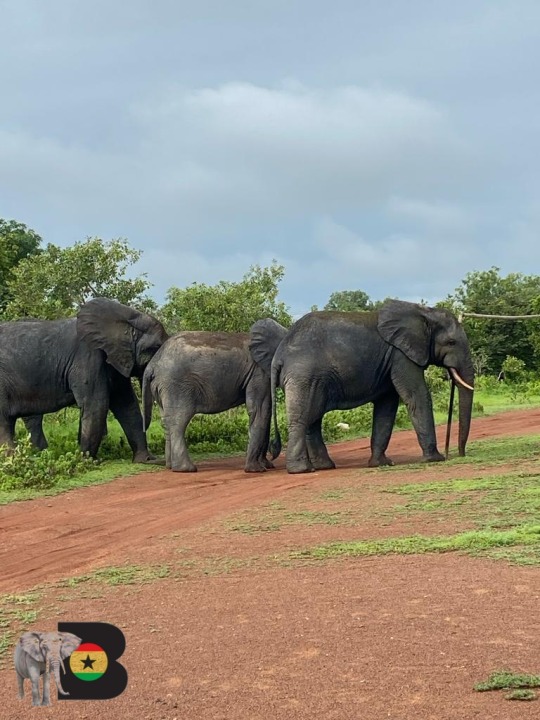
Discover the Essence of Ghana Vibrant Cities, Serene Beaches, and Rich Traditions.
Ghana, a country in West Africa, is a treasure trove of cultural diversity, natural beauty, and vibrant cities. From the bustling streets of Accra to the serene beaches of Cape Coast, Ghana has something for everyone. In this blog post, we'll take you on a journey through the best of Ghana, exploring its rich traditions, stunning landscapes, and vibrant cities.
Vibrant Cities
Ghana's cities are a fusion of traditional and modern culture. Accra, the capital city, is a must-visit, with its vibrant markets, historical landmarks, and nightlife. Kumasi, the cultural hub, is home to the Ashanti Kingdom and its rich heritage. Tamale, in the north, is a melting pot of cultures, with a unique blend of traditional and modern architecture.
Serene Beaches
Ghana's coastline offers a relaxing escape from the hustle and bustle of city life. Cape Coast, with its stunning beaches and historic castles, is a popular destination. Elmina, with its picturesque fishing village and beautiful beaches, is another must-visit. Busua, a serene beach town, is perfect for relaxation and water sports.
Rich Traditions
Ghana is renowned for its rich cultural heritage. The Ashanti Kingdom, with its vibrant Kente cloth and traditional drumming, is a highlight. The Akwasidae festival, celebrated by the Ashanti people, is a colorful display of traditional dance, music, and costume. The Ewe people, in the east, have a unique tradition of storytelling and music.
Natural Beauty
Ghana's natural beauty is breathtaking. The Volta Lake, the largest man-made lake in the world, is a stunning sight. The Afadjato Mountain, the highest peak in Ghana, offers breathtaking views. The Wli Waterfalls, in the east, are a scenic delight. The Mole National Park, in the north, is home to a diverse range of wildlife.
Ghana is a country that has something for everyone. From vibrant cities to serene beaches, rich traditions to natural beauty, Ghana is a destination that will leave you in awe. With Best Ghana Tours, you can experience the best of Ghana, with our expert guides and carefully curated tour packages. So why wait? Book your Ghana tour today with Best Ghana Tours to discover the essence of Ghana!
#bestghanatours#travel#tourism#tour package#ghana#accra ghana#travelwithus#tourist#worldwide privacy tour#summer#all inclusive#accra#activity#tamale#landscape#europe#africa#beauty#nature#wildlife#culture#cape coast#heritage#yearofreturn#beyondthereturn#new york#united states
16 notes
·
View notes
Text
The Enduring Spirit of the Maasai People
The Maasai people, with their vibrant red shukas (robes) and rich cultural traditions, are a captivating aspect of East Africa. Inhabiting parts of Kenya and northern Tanzania, they've captured the world's imagination for centuries. Let's delve into their fascinating world and explore what makes them unique.

A Legacy of Pastoralism
Traditionally, the Maasai are semi-nomadic pastoralists. Their lives revolve around herding cattle, sheep, and goats. These animals are central to their way of life, providing sustenance, social status, and dowries for marriage. The Maasai have an intimate understanding of their environment, moving their herds to find the best grazing lands based on seasonal changes.
Deeply Rooted Traditions
Maasai society is complex and age-based. Men progress through a series of age sets, each with specific roles and responsibilities. Young warriors, known as Moran, are known for their bravery and elaborate beadwork. Women play a crucial role in building and managing the communities (manyattas) and raising children.
Living in Harmony with Nature
The Maasai have a deep respect for nature, believing in a strong connection between themselves, their livestock, and the land. Their traditional religion emphasizes living in balance with the environment. This respect is evident in their intricate understanding of wildlife behavior, allowing them to coexist with animals like lions and zebras.
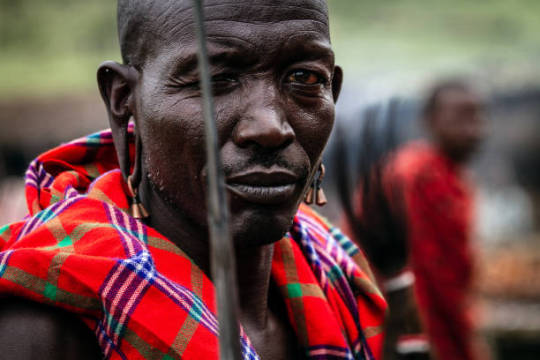
Facing the Winds of Change
The Maasai way of life faces challenges in the modern world. Encroachment on their grazing lands, drought, and the lure of a more sedentary lifestyle threaten their traditional practices. However, the Maasai are a resilient people. Many communities are adapting, engaging in ecotourism and cultural preservation efforts to secure their future.
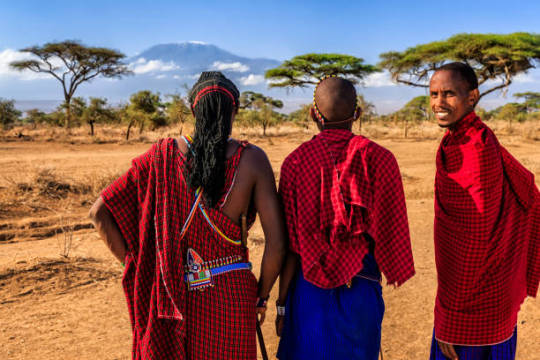
Experiencing the Maasai Culture
If you're fortunate enough to visit East Africa, consider visiting a Maasai community. Witnessing their dances, learning about their traditions, and supporting their businesses can provide a glimpse into their remarkable culture and contribute to its preservation.
The Maasai people are a testament to the power of tradition and resilience. Their enduring spirit and respect for nature are an inspiration for us all.
#ugandian knuckles#tourist#tourism#wild animals#tour#Adventure#photography#beach#safari#africa#Nairobi#Uganda#Kenya#Masai Mara#beaches#Wanderlust#east africa#Travel Photography#travel blog#tanzania#tanned#zanzibar#tangled#tanzanite#kenyan#kenya moore#beachlife#Kenya Safari#Nairob#travel
3 notes
·
View notes
Quote
This, in turn, has meant that our 21st-century war on terror, the most prolonged set of U.S. conflicts since the Vietnam era, has been handled by volunteers who experience both longer and more frequent deployments and return home to ever fewer people who have the slightest idea what they’ve been through. As a result, many Americans are now unfamiliar with what killing people professionally does to you. Most have no idea what it’s like to see a family member return from a military deployment in the Middle East or sub-Saharan Africa completely changed—with a 1,000-yard stare that makes eye contact hard, a tendency to startle at loud noises, and possibly a formidable temper. For many privileged Americans fortunate not to live that life or dwell in crime-ridden neighborhoods, violence is something left to Hollywood movies until, at least, someone opens up with an automatic weapon in your local supermarket or dance hall.
How the War on Terror Helped Cause Us to Turn on Each Other
8 notes
·
View notes